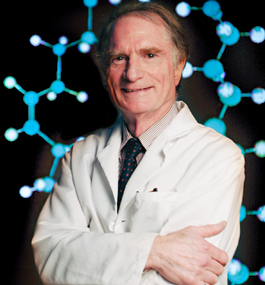U.S. Supreme Court Hears Case on University Patent Ownership

Mike Lovett
K.C. Hayes
by Laura Gardner
Brandeis has joined dozens of other leading research universities in an amicus brief filed in a Supreme Court case that could have profound consequences for the successful commercialization of federally funded research at universities. At issue is the disposition of patent rights under the historic Bayh-Dole Act of 1980, which allowed universities and other nonprofit institutions to own the discoveries resulting from federally funded research. Arguments before the Supreme Court were scheduled for late winter, and a decision is expected by the end of June.
In the case, brought by Stanford University against Roche Molecular Systems, the high court agreed to decide whether a university’s right to own patents in inventions arising from federally funded research can be terminated unilaterally by an individual faculty inventor’s assignment of his rights to a third party.
The case stemmed from a licensing dispute between Stanford and Roche over ownership of patents used in the drug company’s HIV test kits. The Stanford professor who developed the technology in the test kits later assigned licensing rights to a biotechnology company that was eventually bought by Roche. At issue is whether Bayh-Dole negates the third-party licensing agreement that the professor made. In other words, who owns the patent rights, Stanford or Roche?
“The Bayh-Dole Act has been one of the most successful economic development laws ever passed,” says Irene Abrams, executive director of Brandeis’ Office of Technology Licensing. According to Ropes & Gray, the Boston law firm that filed the friend-of-the-court brief, university patent licensing from 1996 to 2007 contributed an estimated $187 billion to U.S. gross domestic product. The legislation was created to leverage the public benefit of taxpayer-funded university research through what is called technology transfer.
At Brandeis, the Bayh-Dole legislation spurred patent activity in many areas. The university earned almost $1.8 million in patent royalties last year, says Abrams. Currently, the university has nearly 300 active patents and 53 active license agreements. The Smart Balance brand of products, which uses technology developed by lipid expert K.C. Hayes and research scientist Dan Perlman, is the largest single source of patent royalties.
Three years ago, Hayes entered into a $1 million sponsored research agreement with Smart Balance, Inc. Such industry-sponsored research would be in grave jeopardy, Abrams says, if it were unclear who owned the patent rights to university intellectual property. Overall, Brandeis has about $8 million in industry-sponsored research projects under way based on existing patents. Biologist Larry Wangh, whose lab developed a new and improved method of DNA testing, has a long-standing relationship with U.K.-based Smiths Detection, which has supported Wangh’s efforts to develop methods of detecting infectious and other diseases in humans and animals.
“Outside companies will be reluctant to invest in university-owned intellectual property if it isn’t clear who owns the patent rights,” says Abrams, “and that means beneficial university-based inventions and technologies won’t get to market.”
In the case, brought by Stanford University against Roche Molecular Systems, the high court agreed to decide whether a university’s right to own patents in inventions arising from federally funded research can be terminated unilaterally by an individual faculty inventor’s assignment of his rights to a third party.
The case stemmed from a licensing dispute between Stanford and Roche over ownership of patents used in the drug company’s HIV test kits. The Stanford professor who developed the technology in the test kits later assigned licensing rights to a biotechnology company that was eventually bought by Roche. At issue is whether Bayh-Dole negates the third-party licensing agreement that the professor made. In other words, who owns the patent rights, Stanford or Roche?
“The Bayh-Dole Act has been one of the most successful economic development laws ever passed,” says Irene Abrams, executive director of Brandeis’ Office of Technology Licensing. According to Ropes & Gray, the Boston law firm that filed the friend-of-the-court brief, university patent licensing from 1996 to 2007 contributed an estimated $187 billion to U.S. gross domestic product. The legislation was created to leverage the public benefit of taxpayer-funded university research through what is called technology transfer.
At Brandeis, the Bayh-Dole legislation spurred patent activity in many areas. The university earned almost $1.8 million in patent royalties last year, says Abrams. Currently, the university has nearly 300 active patents and 53 active license agreements. The Smart Balance brand of products, which uses technology developed by lipid expert K.C. Hayes and research scientist Dan Perlman, is the largest single source of patent royalties.
Three years ago, Hayes entered into a $1 million sponsored research agreement with Smart Balance, Inc. Such industry-sponsored research would be in grave jeopardy, Abrams says, if it were unclear who owned the patent rights to university intellectual property. Overall, Brandeis has about $8 million in industry-sponsored research projects under way based on existing patents. Biologist Larry Wangh, whose lab developed a new and improved method of DNA testing, has a long-standing relationship with U.K.-based Smiths Detection, which has supported Wangh’s efforts to develop methods of detecting infectious and other diseases in humans and animals.
“Outside companies will be reluctant to invest in university-owned intellectual property if it isn’t clear who owns the patent rights,” says Abrams, “and that means beneficial university-based inventions and technologies won’t get to market.”
